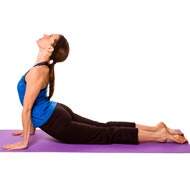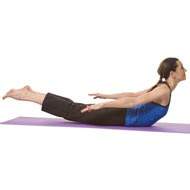Upward-Facing Dog - Urdhva Mukha Svanasana
The Upward-Facing Dog or the Urdhva Mukha Svanasana is a simple resting pose which is very similar to the Bhujangasana or the Cobra pose.
This is a beginner’s pose which can be performed by anyone who has started to learn yoga.
This pose is very simple to perform and benefits your wrists as well as the lower back. There are no Upward-Facing Dog pregnancy variations and if you are pregnant, consult with a doctor and a yoga teacher before performing the pose.
Steps :
- Lie straight on your belly, on a hard surface or a yoga mat. Keep your legs stretched back and in line with your hips.
- Allow the tops of your feet to rest on the floor. Bring your forearms perpendicular to the floor and bend your elbows keeping your palms right besides your waist.
- Take in a deep breath and apply pressure on your hands as if you are pushing yourself along the floor. Now straighten your arms and lift your upper body upwards.
- Feel the tension releasing in your lower back and concentrate your weight on your wrists and hands. You are now in the Cobra Pose. Exhale.
- Take in another deep breath and as you do so, slowly raise your thighs off the floor. Your body will now be supported on your hands and on the tips of your toes. To aid in your pose, roll your thighs inwards so that the pressure on the calves is eased.
- Lift your pubis upwards, forcing it towards your navel and narrow the points of your hips. However, do not tense your buttocks.
- Keep your shoulder blades firm and allow the weight to be concentrated around your sternum. Tilt your head backwards.
- Breathe regularly and hold the pose for about 15 seconds. If you are a more advanced practitioner, you may hold the pose for 30 seconds. Release the pose and exhale.
Precautions :
- For those who are nursing a back injury, this pose is not recommended.
- Since most of your weight rests on your wrists while performing the pose, those with carpal tunnel syndrome should also avoid it.
- If you suffer from frequent migraines and headaches, or if you are pregnant, this pose should be avoided.
Beginner’s Tip :
When performing this pose the chin should not be pointing towards the chest and the shoulders and neck should be straight. The neck and shoulder blades should be perfectly straight. It is important to draw your shoulders away from your face actively. Only then can you reap the benefits of this pose.
Benefit To Body Part :
- The best benefit to body parts is to the wrists. The pose helps in strengthening the wrists as the body weight is on the wrists
- Your lower back will also benefit from the pose as it stretches the lower back muscles
- It stretches the muscles of the chest and shoulders.
- It stimulates and tones the abdominal muscles and organs
- It helps improve the overall posture of the body.
Therapeutic Applications :
The best therapeutic applications for this pose are for sciatica—the lower back pain caused due to the pressure on the sciatic nerve, or lower back pain in general. This pose can be performed along with the Cobra pose as well.
Variations :
There are no specific variations for Upward-Facing Dog. However, you can make the pose more challenging by pushing yourself forward from the back of your knees. You will feel a pressure on your calves and the tops of your feet will be pressed harder against the floor when you do this.
Preparatory Poses :
- Bridge Pose(Setu Bandha Sarvangasana)
- Cobra Pose (Bhujangasana)
Follow Up Poses :
- Mountain Pose (Tadasana)
- Hero Pose(Virasana)
- Bow Pose (Dhanurasana)
- Camel Pose (Ustrasana)
- Cow Pose (Bitilasana)
- Fish Pose(Matsyasana)
- King Pigeon Pose (Kapotasana)
- Lord Of The Dance Pose (Natarajasana)
- One legged king Pigeon Pose (Eka Pada Rajakapotasana II)
- Upward Bow Pose (Urdhva Dhanurasana)
- Wild Thing(Camatkarasana)
- Two-Legged Inverted Staff Pose (Dwi Pada Viparita Dandasana)



